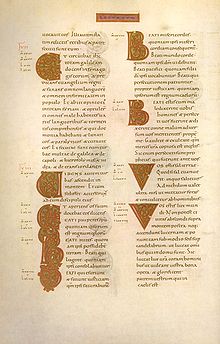- Codex Aureus of Echternach
-
The Codex Aureus of Echternach (Codex aureus Epternacensis) (Nuremberg, Germanisches Nationalmuseum, Hs. 156142) is an 11th century illuminated Gospel Book.
The manuscript contains the Vulgate versions of the four gospels plus prefatory matter including the Eusebian canon tables, and is a major example of Ottonian illumination. It was produced at the Abbey of Echternach under the direction of Abbot Humbert.
The manuscript has 136 folios which measure 446 mm by 310 mm. It is one of the most lavishly illuminated Ottonian manuscripts. It contains over 60 decorative pages including 16 full page miniatures, 9 full page initials, 5 evangelist portraits, 10 decorated pages of canon tables, and 16 half-page initials. In addition there are 503 smaller initials. The text is writtien in gold ink. The front cover of the manuscript is an Ottonian treasure binding which dates from about 50 years before the manuscript.
The manuscript was Abbey of Echternach in today's Luxembourg before it was sold to Ernest II, Duke of Saxe-Gotha-Altenburg, in 1801. Today it is owned by the Germanisches Nationalmuseum in Nuremberg.
References
- Walther, Ingo F. and Norbert Wolf. Codices Illustres: The world's most famous illuminated manuscripts, 400 to 1600. Köln, TASCHEN, 2005.
External links

This article about an illuminated manuscript is a stub. You can help Wikipedia by expanding it.


